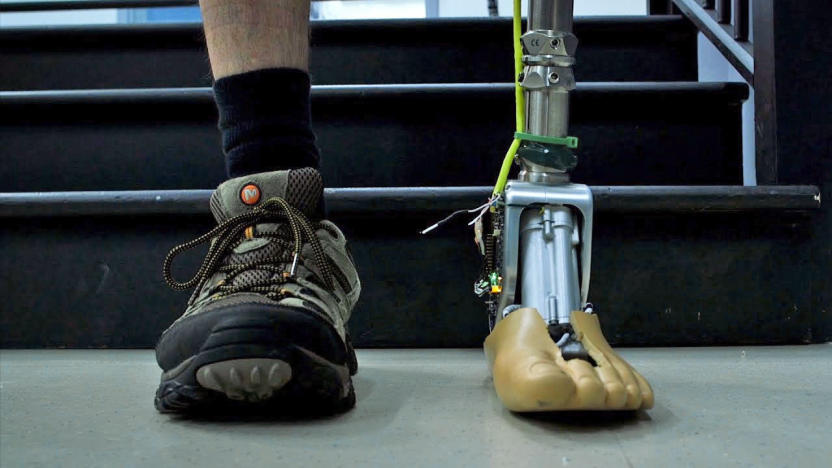Vanderbilt
Latest

Smart prosthetic ankle can adapt to uneven ground
Prosthetic limbs have evolved considerably from the rudimentary wooden appendages of just a few decades ago. They can be bionic, brain-controlled and loaded with features -- and even mimic the sense of touch. But they're still a way off truly replicating the real thing, largely because of issues imitating the many subtle movements and sensations that come naturally to real limbs. Now, however, a new prosthetic ankle is overcoming these challenges.

Researchers improve spinach-based solar cells by adding blackberry dye
Biohybrid solar cells aren't nearly as efficient as standard silicon panels, but including natural materials in renewable energy could make it more cost-effective. Scientists have refined one design based on the proteins in spinach leaves by adding natural dye extracted from blackberries, a combination which apparently produces much more voltage than the greens alone.

Smartphone problems? Space particles may be to blame
Here's a new one. Space particles from the sun and even distant black holes are affecting microelectronic devices more than ever, according to a recent study from Vanderbilt University. Chip manufacturers are packing in more transistors, increasing the chances a high-energy particle will strike one. While rare, such "bit-flips" may have caused a Qantas aircraft plunge and voting machine failure. With electronics devices all over the place, it's forcing designers to take the phenomenon into account.

ICYMI: Cotton Candy body parts, robotic bartender and more
#fivemin-widget-blogsmith-image-27934{display:none;} .cke_show_borders #fivemin-widget-blogsmith-image-27934, #postcontentcontainer #fivemin-widget-blogsmith-image-27934{width:570px;display:block;} try{document.getElementById("fivemin-widget-blogsmith-image-27934").style.display="none";}catch(e){}Today on In Case You Missed It: Vanderbilt University scientists whipped up some human capillaries by using a cotton candy machine to properly shape channels for the blood vessels. A Kickstarter project is selling a tiny video camera attachment with a flexible cord to aim and drop it into places you normally can't see, like inside a car engine. And the University of Maryland is training a robot to make drinks by watching a human; a process that is far more adorable than you'd first think.

Spinach-based solar cells get $90,000 development funds from EPA, Popeye delighted
A biohybrid solar panel that substitutes expensive silicon components for a spinach protein has been granted some substantial Phase II funding from the EPA. Students from the Vanderbilt School of Engineering managed to stand out from 44 other university teams vying for funding at the National Sustainable Design Expo held in Washington DC. The team's large-scale panel only ekes out a small amount of electricity from the photosynthetic proteins at the moment, but according to Professor Kane Jennings, the cash injection from the EPA will help achieve higher energy conversion ratios over the next few years. Perhaps you could try wrapping them up into giant 3D cubes, Professor. [Thanks Brandon]

App turns Android tabs into math tools for the visually impaired (video)
Two high school students are taking part in a bit of an experiment at Vanderbilt University. The college's Medical and Electromechanical Design Laboratory (MED Lab) is working on an Android app that turns tablets into a teaching aid for the visually impaired. Areas of math that rely heavily on visual elements, such as algebra and calculus, prove problematic for students with poor eyesight. A common solution involves pipe cleaners, a cork board and push pins, to recreate graphs, but the method is quite slow. The MED Lab is looking to haptic feedback as a way to help the visually impaired identify lines, graph points and other data that is normally represented visually. For more details about the project check out the video after the break.

Bionic leg anticipates wearer's movements for more natural motion
Vanderbilt University researchers have debuted a new prosthetic leg that promises a more natural walking experience. Built-in sensors monitor the wearer's movement, data which is sent to a microprocessor, in order anticipate motion. The knee and ankle joints, meanwhile, work in unison, considerably cutting down on the sort of lag this is customary with more traditional prosthetic devices, a fact confirmed by tester Craig Hutto. The bionic limb, which took some seven years to develop, can increase the walking speed of its wearer by up to 25 percent, thanks to its need for considerably less energy from the user than passive prosthetic limbs. Check out a video of the leg in action at the source link below.

Graphene coatings used to repel, attract water, could make Rain-X decidedly obsolete
Graphene looks poised to replace our silicon and our touchscreens, even fix our batteries. Now it's due for something perhaps a little less revolutionary: keep our pants clean. Physicist James Dickerson and a team of researchers at Vanderbilt University have created two ways to apply thin graphene sheets that either make them super-hydrophobic or super-hydrophilic. These alternate arrangements, termed "rug" and "brick," make the water bead up and run off or spread out and form incredibly thin sheets. Potential applications are windshields that don't need wipers, pants that cause red wine drops to just bounce off, and goggles that never, ever fog -- no buffing required.

Infrared laser shown to quicken heart rate, gives hope for ultra-small pacemakers
Here's an interesting one. Just years after a researcher in Japan realized that lasers could stimulate nerves, a professor of biomedical engineering at Vanderbilt University along with cohorts from Case Western Reserve have found that the same is true with the heart. By using an Infrared laser on an early embryonic heart, tests were able to show that the muscle was "in lockstep with the laser pulse rate." The crew also found no signs of laser damage after a few hours of experimenting, though obviously more extensive research would be required before any medical agency allowed such a device to be beamed underneath a human chest. The hope here is that this discovery could one day lead to ultra-small, implantable pacemakers, or better still, to "pace an adult heart during surgery." There's nary a mention of when this stuff will actually be ready for FDA oversight, but there's a downright creepy video of it all in the source link. Consider yourself warned.

World's smallest periscope provides multi-dimensional view of cells
We never thought we'd say this, but the standard microscope's day may be coming to an end. Okay, so maybe that's a stretch, but a new device conjured up by scientists at Vanderbilt University sure could stand in as a suitable and deserving replacement. In what's being described as the world's smallest version of the periscope, the so-called mirrored pyramidal wells are being used to allow researchers to see several sides of cells simultaneously. The pyramidal-shaped cavities are molded into silicon "whose interior surfaces are coated with a reflective layer of gold or platinum," and when a cell is placed inside, it gives Earthlings a magical multi-dimensional view. It's said that this technology is actually stupendously inexpensive compared to other methods of 3D microscopy, and according to Vandy's own Ron Reiserer, this "could easily become as ubiquitous as the microscope slide." Them's fightin' words, no?[Via Physorg]

Rocket-powered mechanical arm might boost prosthetic tech
A group of researchers at Vanderbilt have built a mechanical arm that outperforms traditional battery-powered prosthetics the old-fashioned way: by strapping on a couple rocket motors. The arm, which the team built for DARPA's Revolutionizing Prosthetics 2009 program, relies on a modified miniature version of the same rocket motors the space shuttle uses to reposition itself in space: hydrogen peroxide is burned in the presence of a catalyst to produce pure steam, which is then used to move the arm. Unlike the batteries in traditional arms, which die quickly, a small canister of hydrogen peroxide concealed in the arm can last up to 18 hours, and provides about the same power and functionality of a human arm. Cooler still is the method the arm deals with waste heat and steam: just like a regular arm, it's allowed to filter up through a permeable skin, producing "sweat" -- the same amount of perspiration you'd get on a warm summer day, according to the team. Check a video of the arm in action at the read link -- it's even niftier than it sounds.

Arkansas school to trial iPod, WiFi-equipped school bus
If you thought taking a ride on the GamerBUS was a thrill, this one will really make you long to be a youngster in Arkansas again. Reportedly, the Sheridan school district is launching the Aspirnaut Initiative to bring laptops, iPods, and wireless internet right onto Bus 46, and amazingly, they expect kids to actually glean knowledge rather than hit up a round or two of Counter-Strike. The project hopes to make the unbelievably long (three hours, to be exact) commute that some rural students face a bit less boring and a tad more educational, as students will have access to informational podcasts and web-based learning modules whilst cruising on home. Interestingly, the three-year pilot project will not give students class credit for their extra effort initially, but for brainiacs who stick with the program, they'll purportedly be keeping the goods for themselves once the trial run concludes.[Via ArsTechnica]








